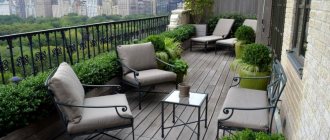Vertical gardening is a design technique that can be used not only in gardens. To turn balconies into real summer oases, you don’t have to limit yourself to just balcony boxes and a potted garden. Using design methods that take up minimal space but create beautiful blooming walls, you can achieve the stunning effect of immersing yourself in wonderful colors and aromas. Growing ordinary annual vines, placing a large number of ampels on the wall or creating a real green fur wall - there are plenty of options for decorating balconies with flowers.
Using vertical gardening in summer, a balcony can be turned into a real garden. © aboutespanol
Advantages of vertical gardening of balconies
In summer, balconies turn into real recreation areas. Many indoor plants migrate here, and minimal costs and care efforts make it possible to create a full-fledged potted garden on the territory of even the smallest balcony. Closed and heated, open, large and miniature, in summer balconies can become a wonderful blooming oasis. Surrounded by colorful flowering plants, it is so pleasant to enjoy your morning coffee, a cool cocktail, the evening breeze or a conversation in the sunset sun.
Even displaying simple summer flowers in pots or several balcony boxes can make the balcony space look elegant. But nothing, perhaps, compares in effectiveness and beauty with flowering walls. This method of vertical gardening on a balcony creates the feeling of a solid wall of plants. At the same time, a flowering wall does not necessarily have to be the wall of a house. A flowering wall can be created at the end, partition or part of the facade of the balcony, used as a screen or protection from the bright summer sun.
Eco-friendly, creating not only a joyful atmosphere, but also a pleasant microclimate on the balcony, saving from excessive heat and purifying the air, vertical walls recreate the comfort of a blooming garden in a small balcony space. And the best approach to creating them is when inspiration is drawn from landscape design and gardening techniques and job satisfaction is experienced.
Drawing up a sketch, determining the landscaping area, initial conditions and selecting plants for them to realize the idea - these are all the steps that need to be taken at the planning stage.
The most unpretentious balcony flowers
Any gardener would like to care for the plants on the balcony minimally and at the same time admire their long and lush flowering. Fortunately, there are types of flowers that meet all these requirements.
5 most popular unpretentious plants:
- Marigold. These flowers are known to everyone. The abundance of varieties allows you to choose plants with very different colors (yellow, orange, red, variegated) and the degree of petal terry. When planted on a balcony, only low-growing species, whose height does not exceed 15–25 cm, will look beautiful. Some hybrid marigolds grow in the form of a bush. It will be enough to plant 1-2 plants in a box; in the future they will grow greatly. Flowering of marigolds begins in early summer and continues until frost. In order for plants to always look decorative, it is necessary to promptly remove faded buds.
- Pelargoniums. The popular name of this plant is geranium. The flower grows well, blooms luxuriantly all summer, and has a spicy scent. Classic color options are red and white; more modern varieties have a wide range of colors, up to a dark burgundy, almost black hue. For the winter, the flower can be moved indoors, where it will continue to bloom. Geranium is perfect for creating compositions. Florists recommend combining it with evening primrose, bacopa, immortelle, and petunias.
- Nemesia. Low compact bushes perfectly decorate the balcony. For more luxuriant flowering, young seedlings are pinched after planting. Flowers are planted in a box at intervals of 20 cm. The colors of nemesias can be one-color, two-color or three-color. Heat shortens flowering time. Nemesia can bloom in 2 waves. To get flowers again closer to autumn, the stems are shortened after the first wave of flowering.
- Fuchsia. To plant these flowers on the balcony in boxes, it is better to choose hanging plant varieties. The flower is unpretentious and easily tolerates shade. Blooming buds cascading down look very impressive and attract the eye. The length of fuchsia shoots can reach up to 50 cm. The color of the flowers is most often red and white. The only important condition for growing fuchsias is regular and abundant watering. After drought, the flower will not recover.
- Pansy (Viola). The height of the plant is only 15–25 cm. There are many hybrid varieties. If the flowers are regularly watered and shaded from the midday sun, they will delight the eye with their beauty for a long time. For lush flowering, plants also need fertilizing. The viola's coloring is very cheerful, combining two contrasting colors (usually yellow-violet). Flowering continues all summer.
A good start is important for annuals, so you need to properly care for the seedlings. If high-quality seeds were used, and the seedlings received everything they needed, then the flowers will grow healthy and strong. Only such plants can bloom beautifully.
Plants for vertical gardening of balconies
In vertical gardening of a balcony, you can use indoor plants - those species that love fresh air and are not afraid of drafts, “happily” moving into gardens and balconies for the summer. But the bulk of the plants should be made up of annual stars - crops that have abundant and long-lasting flowering and are capable of creating color spots and elegant accents in the design.
Even in creating continuous phytowalls, annuals are the main favorites. Lianas or bushy plants allow you to freely form crops and achieve their maximum decorativeness without the need to save the plants for the next year and strictly adhere to the rules of their cultivation.
The choice of plants should be dictated by three main factors:
- your own preferences for shape, color, details of the structure of flowers and leaves;
- the conditions in which the plant will grow (orientation of the balcony to the sunny or shady sides);
- the ability to provide careful care for capricious plants or the preference to choose more hardy species.
When creating vertical gardens and landscaping the walls of a balcony, you can either create neutral background compositions, or try to plant plants so as to get a lush blooming and bright canopy. The color scheme can be changed and selected to suit your taste, combining flowering and decorative foliage plants to achieve maximum effect.
Harmonious pastel colors, bright single-color compositions or contrasts between the main garden colors - the options for decorating your balcony are up to you to choose. The main thing to remember is that plants should complement and emphasize the beauty of each other, contrast in leaves and flower shapes, while maintaining their individuality.
You can grow seedlings for growing annuals or colorful vines yourself or buy ready-made, already flowering, healthy seedlings. With the latter option, it is better to choose plants in containers, carefully assessing the condition of the leaves for traces of pests and the consequences of improper maintenance.
Plants in a vertical balcony garden should complement and highlight each other's beauty
Viola
Bright violas, or pansies, are found in almost every garden. But you can successfully grow this flower on the balcony. Viola is completely unpretentious and will delight you with flowering until autumn. Usually it is planted on sunny balconies, but there pansies can suffer from the heat. Therefore, the northern one is a very good alternative.
And if the sun hits your balcony even occasionally, pansies will bloom much longer than if they grew in bright light.
Be prepared for the fact that when planted in the shade, the viola will bloom smaller and slightly paler than when grown in the sun.
How to care for viola
Viola loves light and loose soil. You need to water the soil as soon as it dries out a little. Moderate watering will help avoid rot, which affects the tender roots of the viola. To achieve flowering, feed the flower weekly with complex fertilizers and inspect it for pests. And once every 10 days, loosen the soil so that a dry crust does not form on the surface. When planting seedlings, leave at least 15-20 cm between plants so that the roots feel comfortable.
The main ways to organize vertical gardening of balconies
When vertically gardening balconies, three design methods are used today:
- Creating a vertical canopy, screen or screen from vines.
- Creating a vertically located potted garden - placing it on a stand or directly on the wall using mounts for a series of potted and hanging plants.
- Creating flowering walls using hydroponics or growing on a fur wall.
Each balcony design option has its own advantages and disadvantages. If you like to tinker and experiment, you can allocate a larger budget, you can afford a hydroponic wall. If you need the least labor-intensive and complex option, then you should choose vines. And if you love Italian, Scandinavian and Spanish motifs, then you can think about colorful potted gardens on the wall.
Azarina
Azarina, or Murandia, is an attractive flowering perennial native to Mexico and also grows in the southern United States. Currently, the liana is very popular among flower growers and garden designers.
The plant has highly branching shoots up to 7 meters long, which cling to the support with thin twisting petioles. Azarina leaves are small, round in shape, with jagged edges and a velvety surface. The flowers are single, large, located along the shoot to the very top. The color of the inflorescences is varied: white, violet, yellow, purple.
Some hybrid varieties are distinguished by two-color petals.
Azarina is a moisture-loving plant, so it requires plenty of watering. To prolong the flowering period, during the dry period the vine can be sprayed with warm water. Care includes mandatory loosening of the soil near the roots and regular weeding.
Classic vertical gardening with vines
A simple stretched mesh made of wire, twine or a fixed trellis made of different materials (metal, wood, plastic), boxes for growing summer plants with installed gratings is the most traditional way to create vertical lines on the balcony. Green and flowering screens, which will create continuous screens on such a support, will allow you to fully use the possibilities of landscaping without losing valuable space.
Creating such a flowering wall comes down to laying drainage, filling the container with substrate and planting plants, the shoots of which will need to be guided and tied up.
For southern and partially southern balconies, the choice of annual vines is especially rich. Here you can use nasturtium, modest in character, but dazzling in color, and exotic kobeya, and airy azarina, and romantic sweet pea, and the inimitable black-eyed thunbergia winged or the fashionable today quamoclite.
If you like original fruits, you can think of decorative pumpkins. You can also grow clematis or climbing roses as a container plant, but in this case you will have to take care of the proper wintering of the vines.
Creepers for shady balconies are a rarity. For these purposes, ivy and vineyards are usually used, which are taken out into the fresh air in the summer. But sweet peas also grow well on the northern balcony, especially if they receive proper care. Another liana that demonstrates amazing unpretentiousness is morning glory, the bright gramophones and no less bright greenery of which look more elegant on the balcony than in the gardens.
Ivy, like a vine, is ideal for use on shady balconies. © idolza
Fuchsia
Evergreen ampelous fuchsias need a small amount of light and coolness for full development. Direct sunlight is destructive for them: the flowers may not open or become crushed. Therefore, plants will like it on the northern balcony. Fuchsia flowers are very unusual, reminiscent of skirts. The stamens are long, with sweet nectar. A very elegant and unpretentious plant!
How to care for fuchsia on the balcony
The flower does not like drought; as soon as the soil dries out, the plant dies immediately, so water the fuchsia regularly and abundantly. But make sure that water does not stagnate in the pot. In addition to watering, fuchsia also needs regular feeding and pruning. Young plants need more nitrogen, and fertilize the grown shoots with phosphorus and potassium, then the buds will cover the entire bush and bloom luxuriantly. To create a beautiful crown, trim the side shoots.
The main pest of the plant is the whitefly, the larvae of which feed on cell sap. But on the northern balcony they most likely will not disturb the fuchsia, because... love warmth. For lush flowering, replant the flower annually in a spacious container.
Vertical potted garden
By attaching fasteners for flower pots to the balcony wall, using multi-level stands, different variations of hanging multi-level shelves, you can create a flowering wall of dozens of pots on the balcony wall.
Today, the choice of “attached” structures is very large. Narrow racks, ladders, shelves, racks, which are often a work of art with forged elements, old stepladders or shelves will help to place plants no worse than “hooks” and brackets with circle stands for pots, and other hanging holders of different sizes and shapes. You can place a series of plants not in containers, but in bags made of canvas or thick fabric, in improvised containers (for example, old tins or an old set).
Of course, there are purely practical limitations in the possibilities of placing large quantities of flower pots on the wall - from the possibility of using reliable fasteners to the stability of materials and the ability to drill holes. Attached shelves simplify the process, but they also need to be securely fastened to prevent the structure from tipping over.
Not every balcony will allow you to hang a dozen pots on the wall. For this option of vertical gardening, be sure to select small, lightweight containers and a very light substrate and drainage in order to reduce the maximum load on the structure.
For potted vertical gardening, be sure to select small, lightweight containers. © Champsbahrain
Choosing Plants for a Vertical Potted Garden
Petunias, pansies and marigolds are the absolute favorites for decorating balconies. But when doing vertical gardening, it is worth considering the growth form of the plants. Ampelous plants with hanging shoots, capable of creating beautiful cascades, are the best choice. Today, even marigolds, pelargoniums, balsams, and begonias have such varieties.
To achieve a particularly striking effect, it is worth combining ampelous plants with bushy ones in complex combinations, which will give the flowering wall from different pots additional volume.
For walls composed of several hanging balcony boxes located one below the other, staggered pots with summerhouses, or a potted garden located on a narrow rack, the choice of crops is carried out based on lighting conditions:
- On the eastern and western balconies, a charming vertical garden can be created from pelargoniums, balsam, begonias, petunias, lobelia, brovallia, bacopa, diascia. Any indoor plants that can be taken outdoors in the summer will feel great here.
- On southern balconies, heather and erica, catharanthus, gerberas, ampelous violas, marigolds, nasturtium, gillyflower, ageratum, carnations, phlox, the same pelargoniums and petunias of hardy small-flowered varieties are more appropriate. Even ampelous strawberry varieties can perform an impressive vertical task. Among indoor plants, cacti, dracaenas, yuccas, agave, laurels, citrus fruits, and aloe can be brought here and used in a vertical garden on a rack or stand.
- On the cooler north side of the house on the balcony for a vertical potted garden, it is better to choose shade-loving indoor plants - ferns, fuchsias, tradescantia, ivy, cherry laurel, aspidistra, cissus. But the choice is not limited to them. Forget-me-nots and mignonette, begonias and marigolds, balsams and coleus will grow on the northern balcony.
If you decide to decorate an open balcony that does not have protection from the wind with a vertical potted garden, then special attention should be paid to the stability of the structures. But pilots also need to be selected more carefully. Calendulas, ageratums, begonias, verbenas, annual asters, chrysanthemums, and gazanias grow well on windy balconies.
In order for such a prefabricated potted garden, placed not in a horizontal, but in a vertical plane, to remain attractive throughout the year, we must not forget to add potted accents to the main gardens. Bulbous and small-bulbous plants, for example, crocuses, hyacinths, tulips and daffodils, followed by primroses, forget-me-nots, daisies and violets will help you wait until the main summer stars begin to bloom. And in the fall, it is worth adding asters, chrysanthemums, several cereal bushes and bright decorative foliage crops to such a garden.
For vertical potted gardens on open balconies, special attention should be paid to the stability of structures
What flowers to plant
Verbena ampelous:
- leaves are dense, hairy;
- flower color - blue, purple, pink, red.
Variety of Verbena flowers.
This plant attracts butterflies and, according to ancient legend, serves as a talisman against ill-wishers.
Lubelia ampelous: small oblong leaves are practically not visible from under the abundant cap of flowers.
Flower color:
- blue;
- blue;
- purple.
Breeders have not yet bred red lubelia! Don't trust enterprising, careless sellers!
Diascia:
- leaves opposite;
- dark green (glossy);
- flower color - purple, salmon, orange, pink.
Their diameter reaches 20 cm. Shoots grow 30-50 cm, depending on the variety.
Fuchsia ampelous: cascading stems decorated with flowers of white-pink, scarlet or lilac-violet color.
The flower reacts sensitively to changes in location, so it is advisable to immediately place the basket or flowerpot with fuchsia in a permanent place.
Moorish bindweed: blooms in all shades of blue all summer without interruption. It is absolutely unpretentious to the soil.
With proper care, flowering lasts until the first frost.
Scaevola has lanceolate leaves that are quite large (up to 9 cm);
Flower color:
- blue-purple;
- lilac;
- blue;
- white.
According to the shape of the flower, all the petals are asymmetrically concentrated on one side of the tube and form a kind of fan.
Ampelous petunias: beautifully flowing vines reach 80 cm.
Plant varieties such as “Snow Queen”, “Dubble Cascade”, “Ramblin” have a pleasant aroma. Such a variety of petunia as “Black Velvet” is beautiful and unusual. We wrote more about petunias here.
The stunning deep black petals appear velvety and form a flower 8-9 cm in diameter.
Ampelous fern: openwork leaves need regular spraying. The width of the leaves can reach 80 cm.
Prefers acidic soil.
Ampelous begonia (Limming's Begonia): the hanging shoots of the plant reach 30-50 cm. The leaves are light green with a yellowish tint.
The color of the flowers varies from light red to coral.
Flowering walls in hydroponics
On balconies you can also use various methods of growing plants not in the traditional way - not in soil, but in special substrates that hold nutrient solutions.
Growing without soil allows not only to make the process “cleaner” and reduce the actual load on the balcony structure, but also opens up new perspectives in care: after all, such plants, as a rule, do not require such complex care. On the balcony, hydroponics and self-watering containers are used both for ordinary plants and for finding new ideas in the design of vertical elements.
For vertical gardening of balconies, you can use several options for hydroponic “walls”:
- vertical walls made of moss with hanging gardens laid out on them;
- using a bag or hanging soft wall, “canvas” with sewn pockets in which plants are planted (usually their base is made of waterproof durable fabrics - tarpaulin, burlap with complex impregnation);
- planting plants in plastic pipes with holes;
- creating a vertical garden in pallets (pallets) converted into “walls”;
- planting plants in converted tubs, canisters and barrels with drilled holes for planting.
You can create a vertical garden using hydroponics using pallets (pallets) converted into “walls”. © Aha
Basic principles for decorating a loggia with vegetation
Remember that plants for decorating open structures and winter gardens should be chosen based on the principles of harmony and arrangement. The design should be designed in such a way that the vegetation fits favorably into the design of the room, but at the same time does not get lost against the overall decorative background.
- The most important rule that must be followed in the process of decorating small balconies is the reasonable use of free space. For example, a small structure can be exquisitely decorated with plants planted in various containers located on the railings. If you place flowers planted in containers on the loggia and then arrange them in a checkerboard pattern, you will visually expand the space of the room;
- A large winter garden can be decorated with vegetation, while respecting the vertical principle. We recommend placing climbing plants along the walls, and then stretching the stems along the threads. You can also decorate shelves with a large number of tiers by placing flowers in pretty pots on the shelves;
- Do you want to decorate your balcony with hedges? Stock up on ivy, clematis, and hops.
Thunbergia
A tropical plant native to South Africa and Madagascar, it is a shrub with long climbing shoots covered with slightly pubescent, heart-shaped leaves. Funnel-shaped flowers are located on long stalks. Their color can be deep red, purple, white, yellow or brown. The flowers of some varieties can emit a strong odor.
Thunbergia is grown as an annual plant because it does not tolerate winter cold.
The liana is easy to care for and requires plenty of watering during the flowering period. Lack of moisture can cause leaves to wilt and buds to fall off. During the summer, mandatory fertilizing should be carried out. Loosening the soil and weeding should be carried out regularly.
Nasturtium
A perennial or annual herbaceous plant introduced from South America, it is often called capuchin. Nasturtiums have long, succulent stems covered with palmate or entire leaves. Tubular-shaped flowers can be simple or double. The petals are often yellow or red.
Nasturtium is known for its healing properties. It is used in cooking for preparing salads or as a seasoning.
Caring for the plant includes mandatory watering and weeding. Watering should be plentiful. During flowering, the soil is moistened when it is completely dry. Overwatering can reduce the number of buds.











